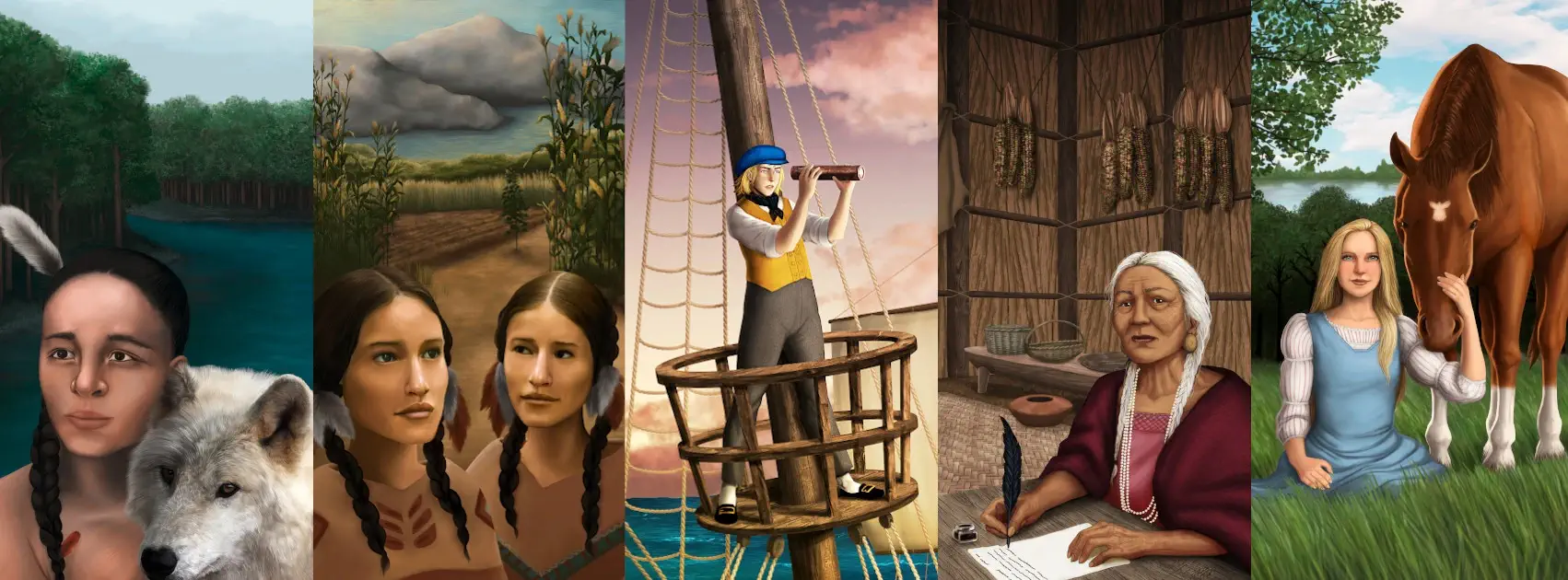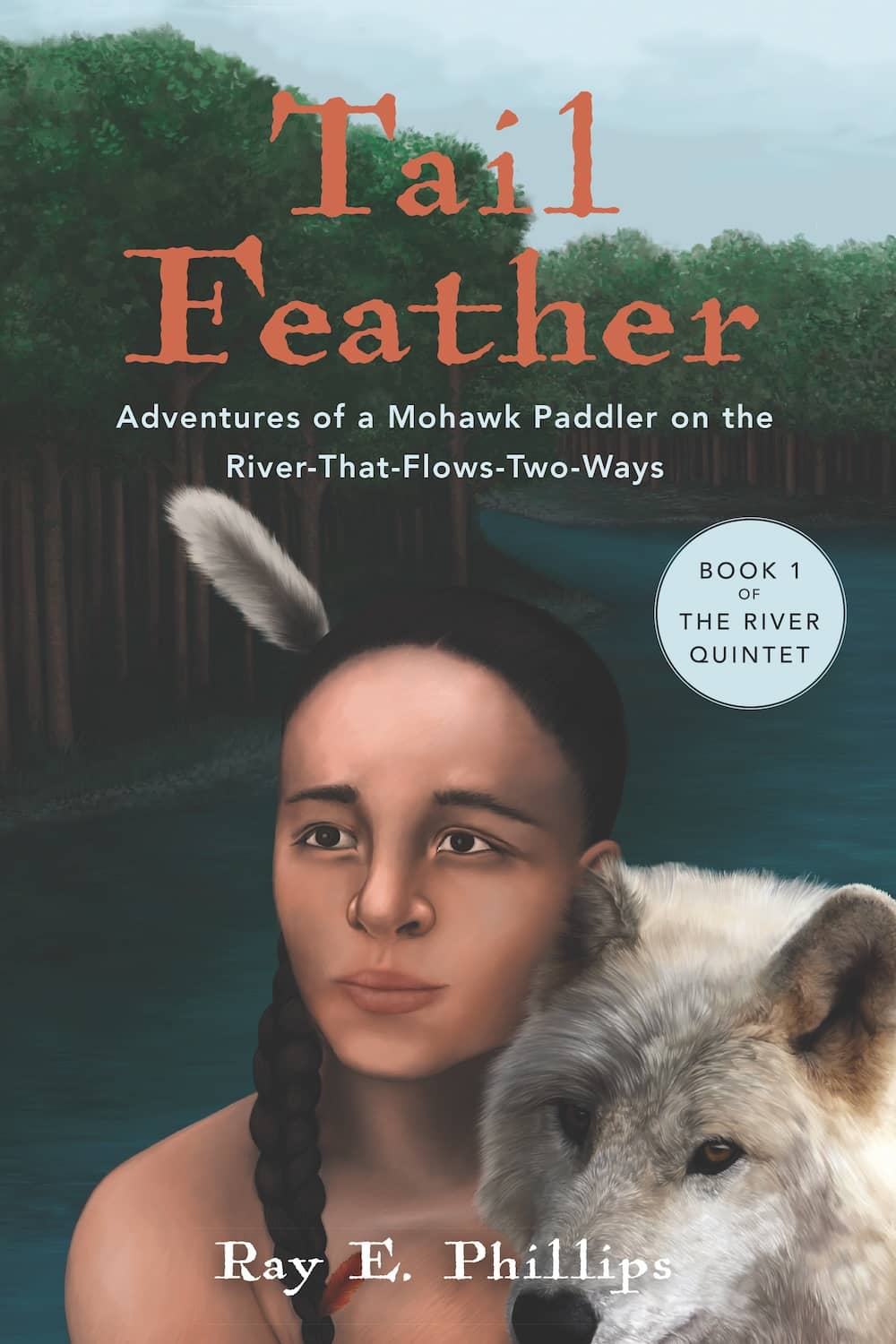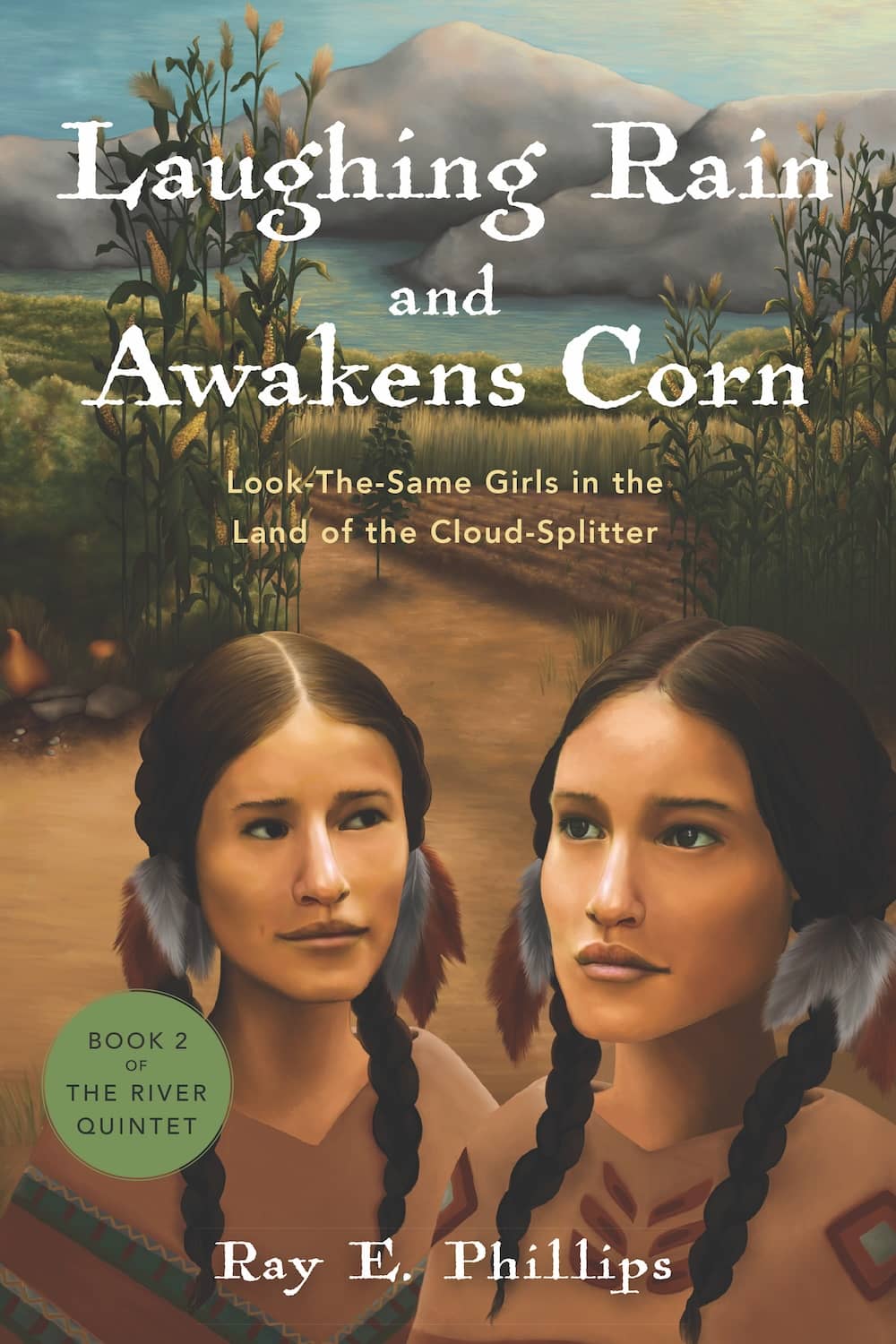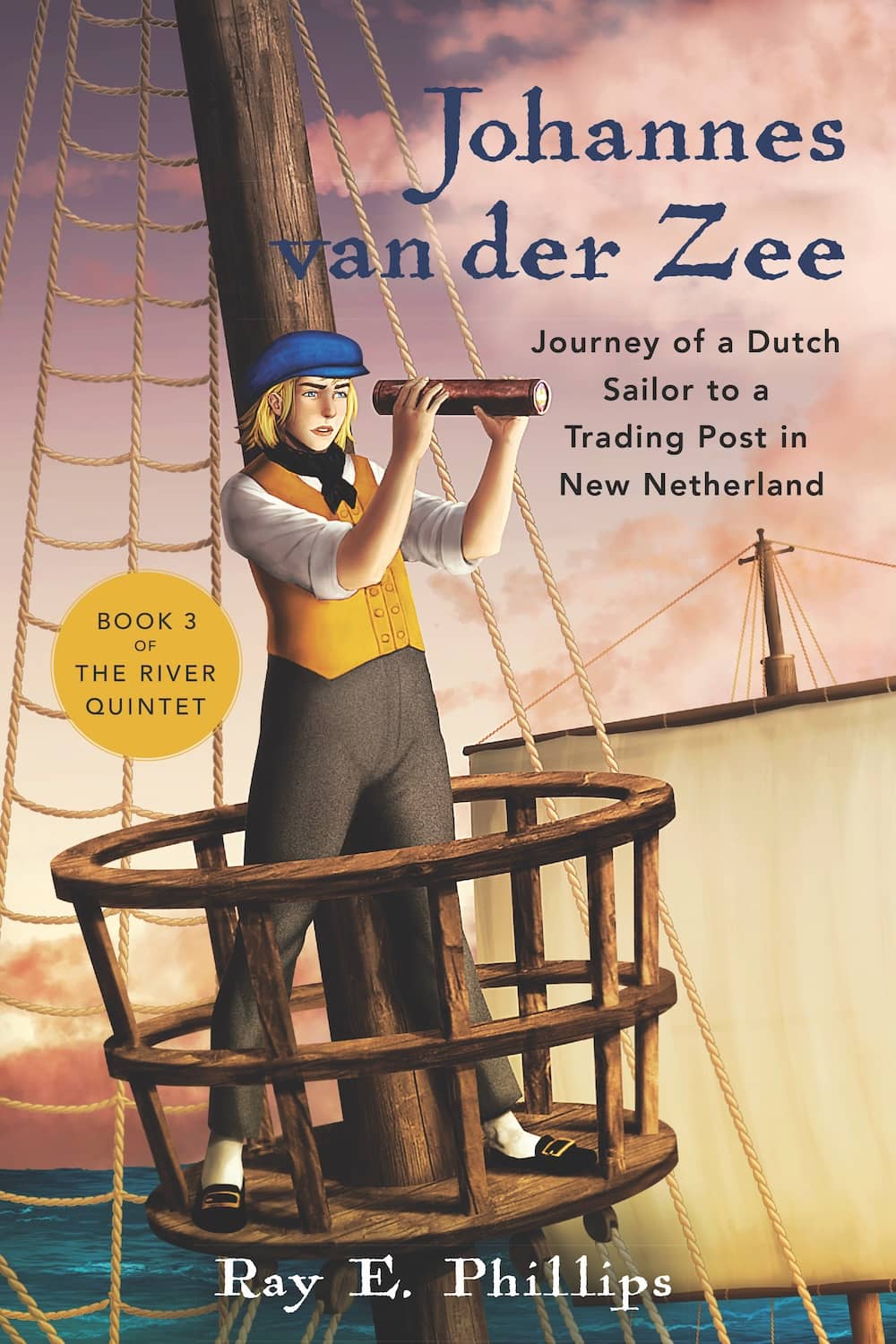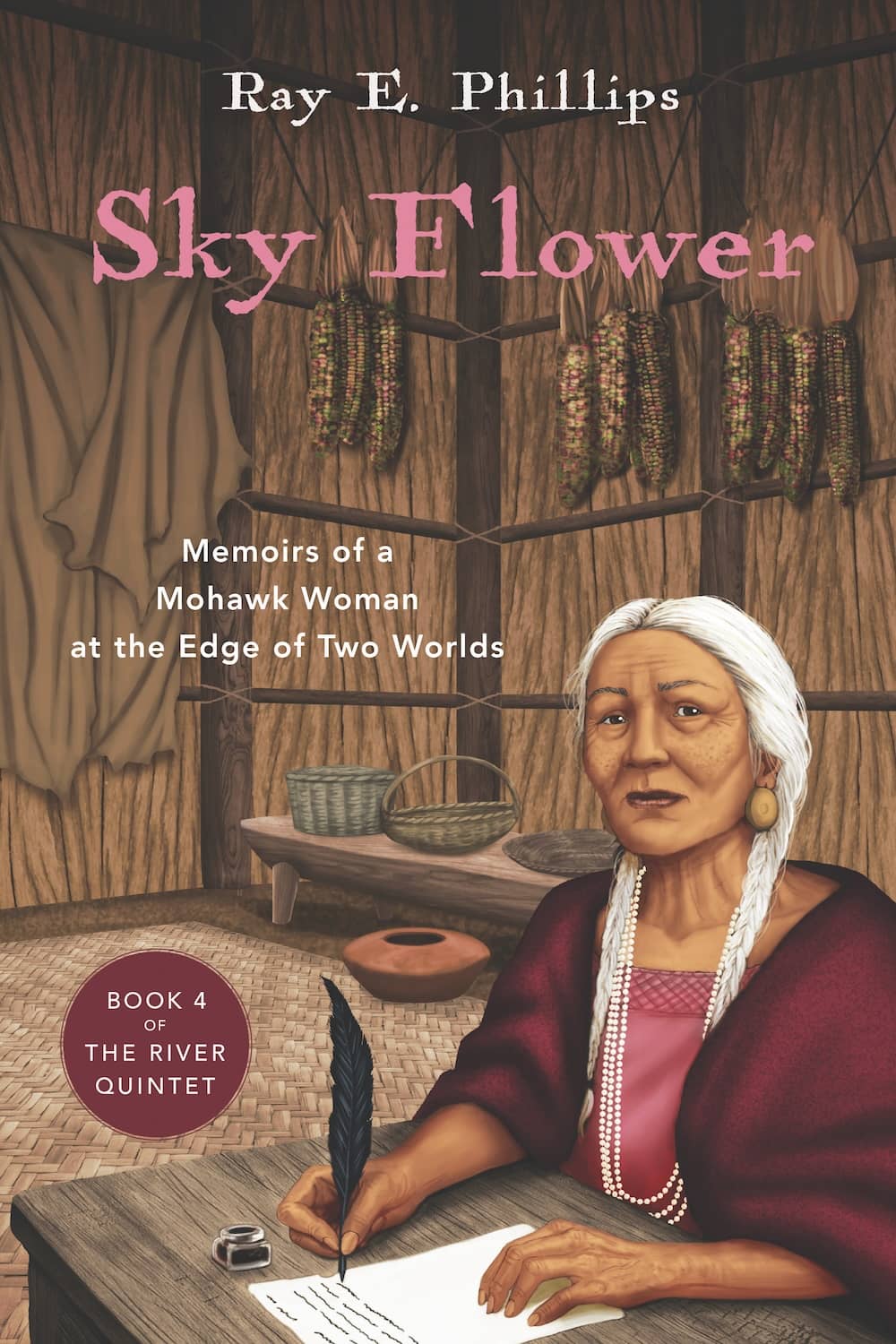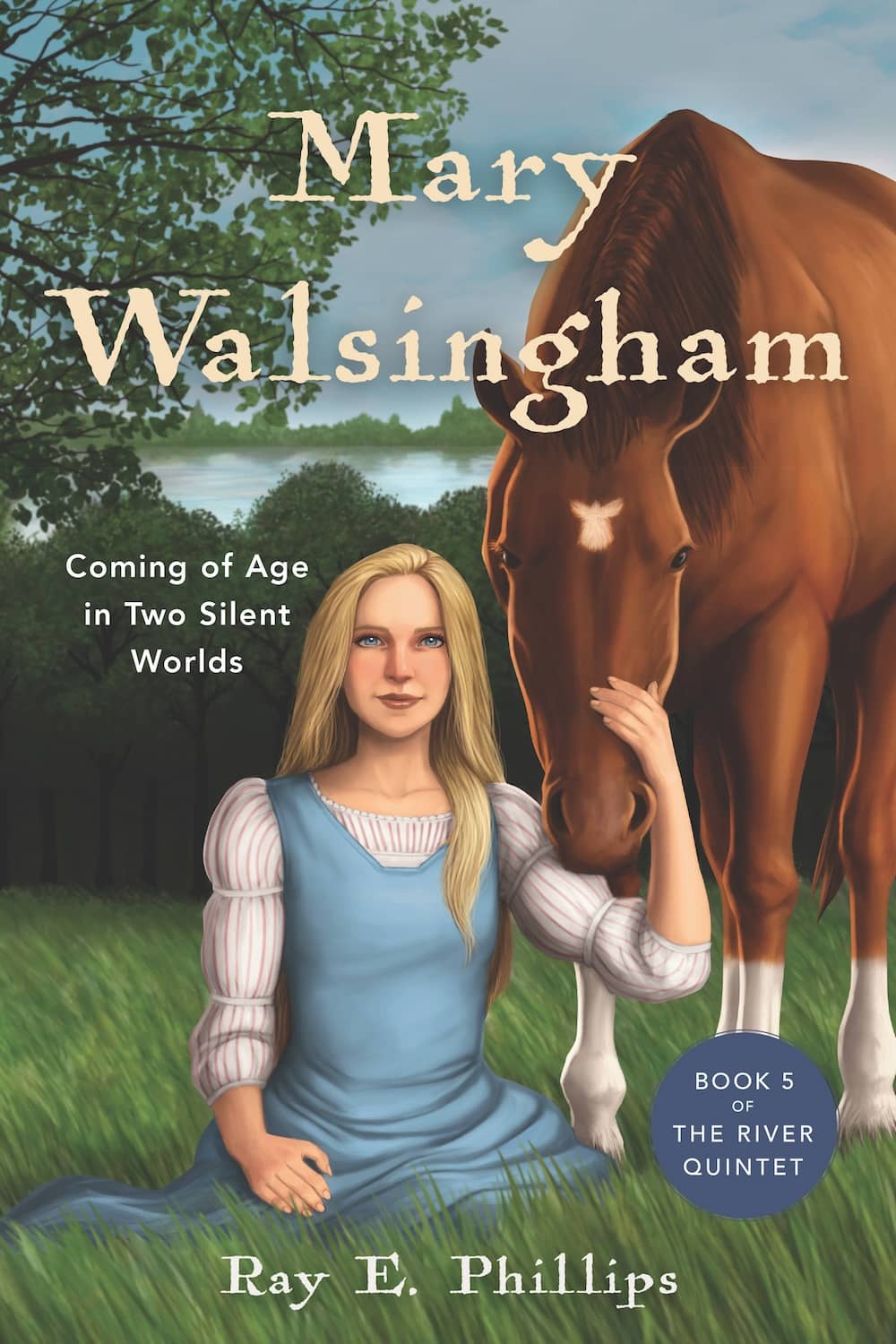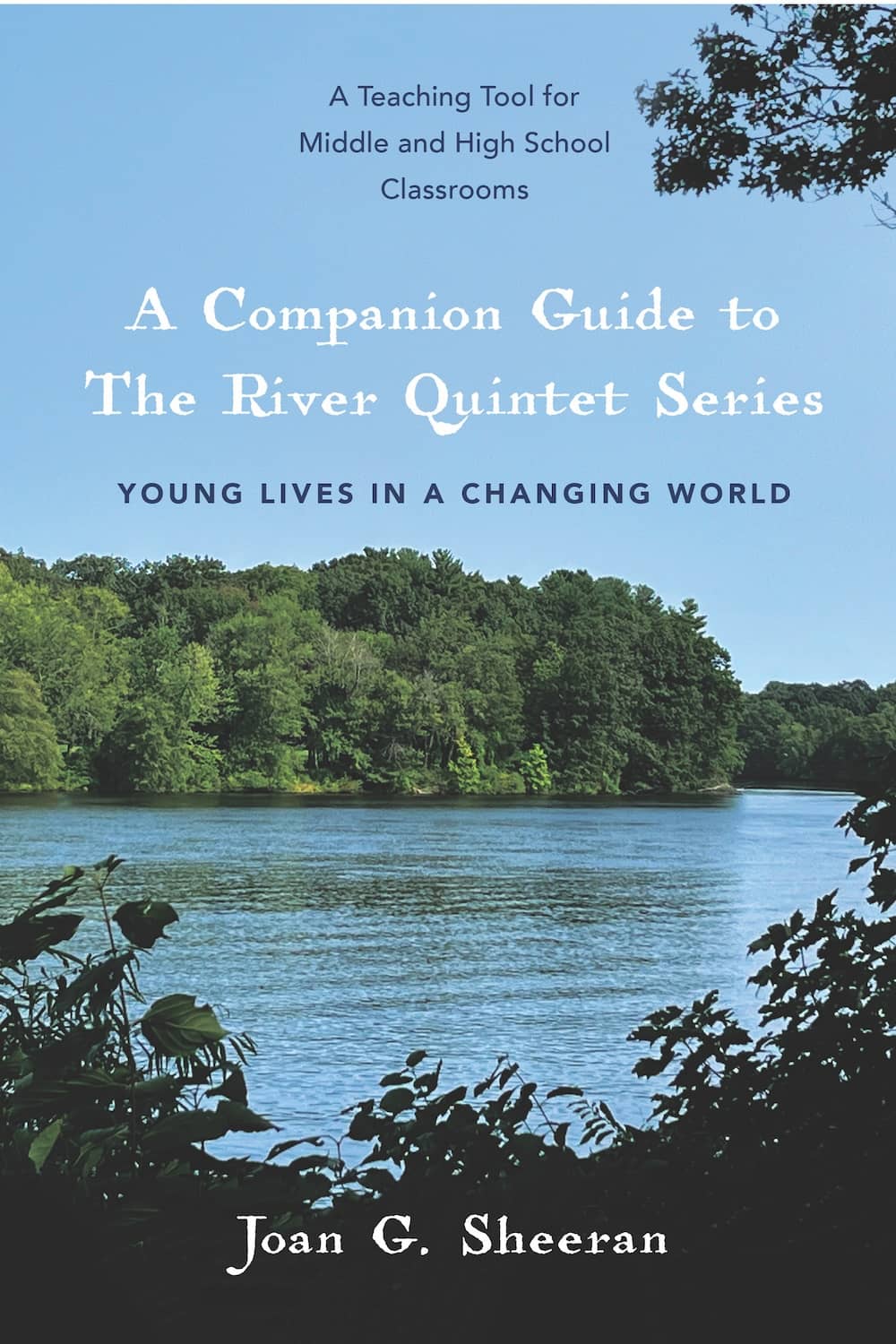The River Quintet:
Young Lives in a Changing World
This series of interrelated historical novels brings readers into the 17th century. There, they will relive the experiences of youthful travelers on long journeys, both geographically and metaphorically in personal development. The stories provide vivid descriptions of life as it was centuries ago, all the while relating to expectations of growing up in the world of today. They take place in woodlands, waterways and dwellings of the time. Rivers referred to in the title are the Hudson River and the Connecticut River of North America, the Thames and its tributaries in England, and the Zuider Zee in the Netherlands.
The novels were revised and reissued in 2024.
How well do you know the Hudson River? Are you interested in taking a cruise from Lake Tear of the Clouds to the Atlantic Ocean? Would you like to experience the journey with each paddle stroke of a Native American youth canoeing the waterway in the 17th century? This voyage – past astonishing landmarks that are little changed in all this time – can be followed in the pages of Tail Feather: Adventures of a Mohawk Paddler on the River-that-Flows-Two-Ways.
This book recounts the joys and hardship of a long journey of discovery more than 400 years ago. It is a coming-of-age story at a time when individual achievements were severely tested but in some ways were not so different than those faced by young people today.
As this panorama unfolds, one can sense the thrill of adventure and, of course, misadventure with its discomfort and danger. Along the way, Tail Feather finds reality in the far-fetched stories listened to since childhood, curled up fireside in the longhouse during long winter nights. One mid-river encounter, however, is wholly unforeseen: the canoes come head-on to a European ship, setting the time in the year 1613. The journey ends at Water-With-No-End, the ocean’s horizon, when an astonishing sight emerges from the depth, bringing to mind an image in a dream early in the story.
Part I, the Story of Tail Feather, contains 198 reference notes that expand various subjects mentioned in the story. In addition to providing factual information, they may also contain little-known fun facts and humor. The following List of Notes in Part II presents an overview of these topics. It is arranged numerically by the chapter number in which each note is located, and by the note number and title as well.
| Chapter | Note | Title |
|---|---|---|
| 1 | 1 | Native Americans |
| 1 | 2 | The Stockade |
| 1 | 3 | The Setting |
| 1 | 4 | The Clan |
| 1 | 5 | The Runner |
| 1 | 6 | Turkey-Feathered Clothes |
| 1 | 7 | Sassafras |
| 1 | 8 | Copper |
| 1 | 9 | Lake Ontario |
| 1 | 10 | Niagara Falls |
| 1 | 11 | Game with Leather Stick |
| 1 | 12 | Howe Caverns |
| 1 | 13 | The Black Robes |
| 1 | 14 | Wampum |
| 1 | 15 | The League of the Iroquois |
| 2 | 16 | The Longhouse |
| 2 | 17 | Activities in Winter |
| 2 | 18 | Telling Stories |
| 2 | 19 | Language |
| 3 | 20 | The Family |
| 3 | 21 | Hunting |
| 3 | 22 | Food in Winter |
| 3 | 23 | Clothing |
| 3 | 24 | Pottery |
| 3 | 25 | Weaving |
| 3 | 26 | Names |
| 3 | 27 | Tools |
| 3 | 28 | Clearing Land |
| 3 | 29 | Planting |
| 3 | 30 | The Cradleboard |
| 3 | 31 | Migration of Birds |
| 3 | 32 | Legends |
| 4 | 33 | Chores for Children |
| 4 | 34 | Maple Syrup |
| 4 | 35 | Bow and Arrow |
| 4 | 36 | Snow-Snake |
| 4 | 37 | Left-Handedness |
| 4 | 38 | The Wolf |
| 4 | 39 | Dreams |
| 5 | 40 | Skunk Cabbage |
| 5 | 41 | The Sky Hunter |
| 5 | 42 | Flint |
| 5 | 43 | People of the Flint |
| 5 | 44 | Bear Grease |
| 5 | 45 | Pretty Stones |
| 6 | 46 | Mount Marcy |
| 6 | 47 | Lake Tear of the Clouds |
| 6 | 48 | Mountain Top Vegetation |
| 6 | 49 | View from a Mountain |
| 6 | 50 | The Eagle |
| 6 | 51 | Headwaters of the Hudson |
| 6 | 52 | Smoke Signals |
| 6 | 53 | Little Continental Divide |
| 6 | 54 | The Hurons |
| 6 | 55 | Adirondack Mt. Trail 121 |
| 7 | 56 | Journey Food |
| 7 | 57 | Wood |
| 7 | 58 | Building a Canoe |
| 7 | 59 | Festivals |
| 7 | 60 | The Sweat Lodge |
| 7 | 61 | Beaver Tail Soup |
| 7 | 62 | Cedar Tea |
| 7 | 63 | The Smoking Pipe |
| 7 | 64 | Dance |
| 7 | 65 | Rhythms |
| 8 | 66 | Moccasins |
| 8 | 67 | The Loon |
| 9 | 68 | Canoe Handling |
| 9 | 69 | Rapids |
| 9 | 70 | Woodland Birds |
| 10 | 71 | Hudson River Gorge |
| 10 | 72 | Linking a Canoe |
| 10 | 73 | Moose |
| 10 | 74 | Repairing a Canoe |
| 10 | 75 | Evergreen Trees |
| 11 | 76 | Blue Ledges |
| 11 | 77 | The Osprey |
| 11 | 78 | The Speckled Trout |
| 11 | 79 | The Snapping Turtle |
| 11 | 80 | The Cougar |
| 11 | 81 | The Butterfly |
| 11 | 82 | Beauty |
| 11 | 83 | Things Bittersweet |
| 12 | 84 | Mohicans / Mahicans |
| 12 | 85 | Rockwell Falls |
| 12 | 86 | The Fate of Captives |
| 12 | 87 | Potholes |
| 12 | 88 | Bone Fracture |
| 13 | 89 | Waterfalls |
| 13 | 90 | Maternal Instincts |
| 14 | 91 | The Mohawk River |
| 14 | 92 | Cohoes Falls |
| 14 | 93 | Rainbow |
| 14 | 94 | Clouds |
| 15 | 95 | Catskill Mountains |
| 15 | 96 | Castle Island |
| 15 | 97 | The White-Tailed Fawn |
| 15 | 98 | The Estuary |
| 16 | 99 | The Marsh |
| 16 | 100 | Trail Food |
| 16 | 101 | Cattails |
| 16 | 102 | The Comb |
| 16 | 103 | The Ramapoughs |
| 16 | 104 | Childbirth |
| 16 | 105 | Twins |
| 16 | 106 | The Snake |
| 16 | 107 | The Moon |
| 16 | 108 | The Great Bear |
| 16 | 109 | The Twin Stars |
| 17 | 110 | Middens |
| 17 | 111 | Regrowth of Land |
| 17 | 112 | Striped Bass |
| 17 | 113 | Portable Water |
| 17 | 114 | Lacrosse |
| 17 | 115 | The Wappingers |
| 17 | 116 | Witch Hazel |
| 17 | 117 | The Poultice |
| 17 | 118 | Black Flies |
| 17 | 119 | Bug Repellent |
| 18 | 120 | The Shad Tree |
| 18 | 121 | The Hudson Highlands |
| 18 | 122 | Pollepel Island |
| 18 | 123 | Breakneck Mountain |
| 18 | 124 | Storm King Mountain |
| 18 | 125 | Hair Styles |
| 18 | 126 | Constitution Island |
| 18 | 127 | West Point |
| 18 | 128 | War Canoes |
| 18 | 129 | The Thunderstorm |
| 18 | 130 | Rough Water Canoeing |
| 18 | 131 | Hypothermia |
| 18 | 132 | The Popcorn Surprise |
| 19 | 133 | Shad |
| 19 | 134 | Popolopen Creek |
| 19 | 135 | The Muskrat |
| 19 | 136 | Hand Signals |
| 19 | 137 | Courtesies |
| 19 | 138 | The Sturgeon |
| 19 | 139 | The Munsees |
| 19 | 140 | Dugout Canoes |
| 19 | 141 | The Tulip Tree |
| 19 | 142 | Personal Hygiene |
| 20 | 143 | Sing Sing |
| 20 | 144 | Granite |
| 20 | 145 | The Tappan Zee |
| 20 | 146 | Tall Ships |
| 20 | 147 | Dutch-English Distionary |
| 20 | 148 | Firearms |
| 20 | 149 | Historical Milestones |
| 21 | 150 | The Palisades |
| 21 | 151 | Fog |
| 21 | 152 | Foxfire |
| 21 | 153 | The Funeral Procession |
| 22 | 154 | The Williow Tree |
| 22 | 155 | The Shorakkopochs |
| 22 | 156 | The Caves of Inwood |
| 22 | 157 | The Healing Arts |
| 22 | 158 | Appendicitis |
| 22 | 159 | The Wolf Pup |
| 22 | 160 | Honey |
| 23 | 161 | The Moccasin Flower |
| 23 | 162 | Island of the Hills |
| 23 | 163 | The Manhattoes |
| 23 | 164 | Body Decorations |
| 23 | 165 | Orthopedics |
| 23 | 166 | Cat’s Cradle |
| 23 | 167 | The Conch |
| 23 | 168 | Domesticated Wolves |
| 23 | 169 | Clams |
| 23 | 170 | Oysters |
| 23 | 171 | Lobsters |
| 23 | 172 | Iron Tools |
| 23 | 173 | The Chestnut Tree |
| 23 | 174 | The Trading Site |
| 23 | 175 | Trading |
| 23 | 176 | Making Wampum |
| 23 | 177 | Words |
| 23 | 178 | Long Distance Commerce |
| 23 | 179 | Albinism |
| 23 | 180 | The Owl |
| 24 | 181 | New York Harbor |
| 24 | 182 | The Harbor Islands |
| 24 | 183 | The Narrows |
| 24 | 184 | Coney Island |
| 24 | 185 | The Canarsees |
| 24 | 186 | The Horizon |
| 24 | 187 | Sperm Whales |
| 24 | 188 | The East River |
| 24 | 189 | The Brooklyn Bridge |
| 24 | 190 | Roosevelt Island |
| 24 | 191 | Hell’s Gate |
| 24 | 192 | Highbridge |
| 24 | 193 | Kingsbridge |
| 24 | 194 | Spuyten Duvil and The Harlem River Ship Canal |
| 24 | 195 | The Island of Manhattan |
| 25 | 196 | Outcasts |
| 25 | 197 | The Gift |
| 25 | 198 | Names for the Hudson River |
You can also download a PDF of the map here!
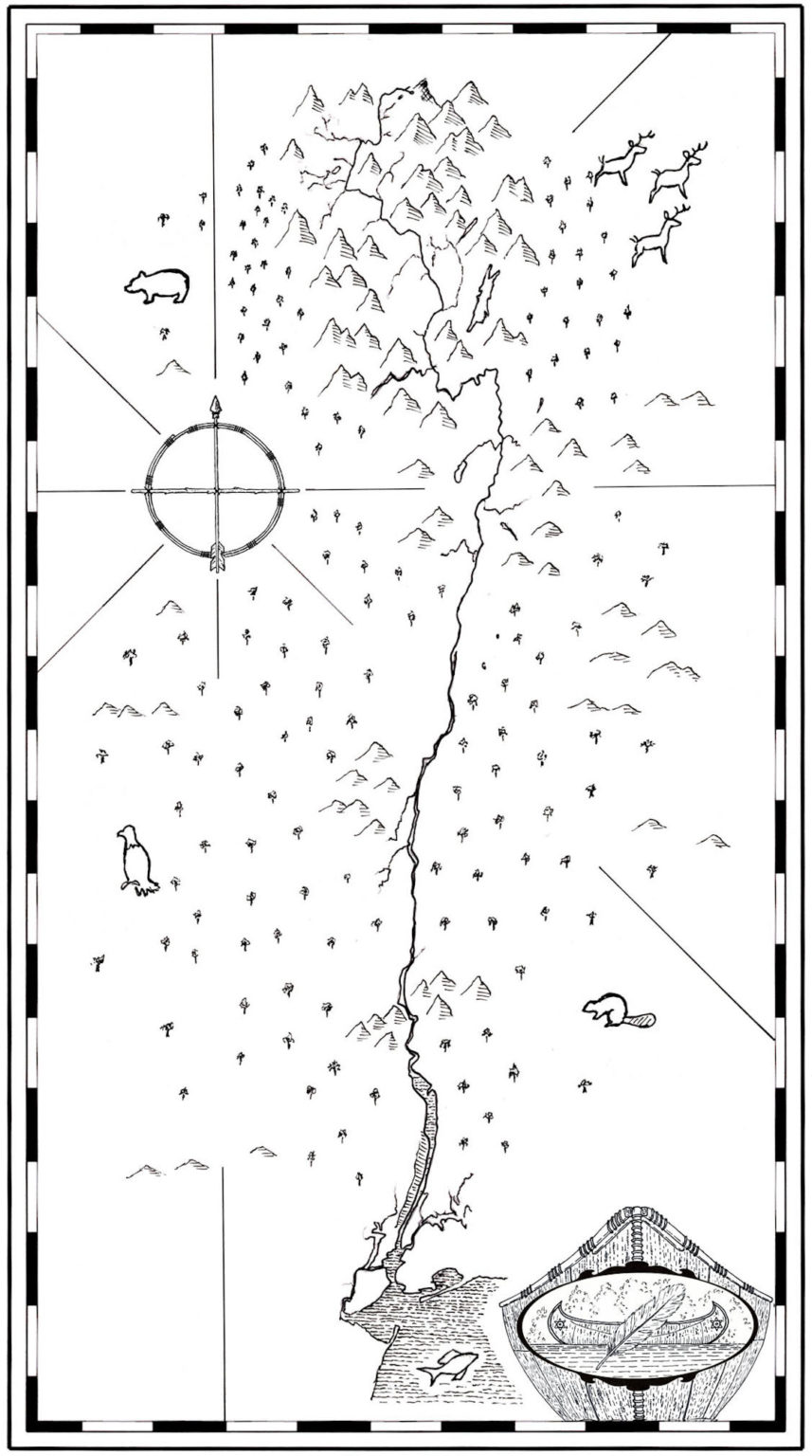
Kenneth Little Hawk is a renowned storyteller and musician featuring the culture of Native Americans. He has performed extensively in schools, museums and at historical restoration sites both in the United States and internationally.
Welcome, welcome, all of you
Every nation, every culture, every color, every hue.
Open your heart so you may hear
More with your spirit, less with your ear.
All my life I have been guided by the wisdom of my ancestors, the Mi’kmaq of Maine and New Brunswick, Canada, and the Mohawks of the Iroquois Nation. Over the years I’ve shared the lessons of my elders around the world.
During those travels I was honored to meet author, Ray Phillips. Our common ground was respect for the wisdom of First Nations’ people as well as appreciation for the knowledge that everyone has a story to tell. Dr. Phillips and I share this ancient culture in different ways. My way is through oral storytelling, music, and dance; his is with pen and paper.
Long ago, when Nature was treated with sacred reverence, indigenous stories were passed on by word of mouth, from heart to heart, from generation to generation, with as many levels as there are in the universe. Through these oral traditions came stories and songs for all ages to entertain, teach, and remind us how we can live in a good way. First Nations’ stories teach that most of life’s challenges can be overcome. They also teach us that we need to share our good-heartedness with all people because we are ALL related.
Over the years, I’ve had the pleasure of reading Dr. Phillip’s stories as they developed. His latest work is The River Quintet. This is a series of five interrelated, stand-alone novels set in a time and place when my ancestors first met Europeans arriving in the northeastern part of what they called the New World. Book One is Tail Feather: The Adventures of a Mohawk Paddler on The River‐That‐Flows‐Two‐Ways.
All the stories are gripping, adventurous, and educational, while sensitive to the indigenous viewpoint, with an understanding of the human spirit and cultural practices of the time, and our relationship to Mother Earth.
I invite all people, their children, and their grandchildren to read Dr. Phillips’ historically detailed, The River Quintet. The stories show how Mother Earth’s people share more common traits and needs than differences, and how to live with respect. A favorite story is in Tail Feather, which tells how the narcissistic bear lost his beautiful tail; at the same time, it offers insight into the rich history and culture of young Native boys.
May you enjoy reading these stories as much as I did!
Author and retired middle and high school teacher of Social Studies with thirty-three years of experience in the Albany City School District. He spent many years as a volunteer crewmember and teacher chaperone on the full-scale replica of the Half Moon, Henry Hudson’s 17th century ship of discovery. He also is the author and/or curriculum resource developer of publications that include:
For the New Netherland Museum / Replica Ship Half Moon
-
Voyage of Discovery: New Netherland—An Exploration of Past and Present, An Interdisciplinary Curriculum for the 4th Grade
-
Voyage of Discovery: New Netherland —An Exploration of a Dutch Colonial Settlement, A Team Teaching Interdisciplinary Curriculum for the 7th Grade
-
Indians of the Hudson Valley—An Exploration of Indian Life: Before, During and After European Contact (1550-1750), A Curriculum Resource for the Elementary and Middle Grades
For the Albany Institute of History and Art
- Hudson River Panorama: 400 Years of History, Art, and Culture—Teacher Resource
- Capital Region 50 Objects – Educator Resource
Tail Feather is an interesting, historically accurate and absorbing tale of a young Mohawk Indian as he begins his coming of age maturation through native customs and rites of passage. Dr. Phillips’ storyline includes representations of nearly all aspects of Native American culture during the early 17th century. Tail Feather experiences life changing situations and decisions that form a foundation for his future and a strong framework for his character.
As an educational tool, Tail Feather would be very appropriate for middle school learners. This first book of the River Quintet introduces a subject matter that will proceed with the development of the reader. Many middle school students are enrolled in schools that utilize team teaching, wings, or looping. Students travel throughout their day in groups that receive instruction from the same team of teachers. This provides for an interdisciplinary approach to learning. Educational themes can be carried over to numerous subject matter classes. Native American cultures introduced in seventh grade cover a scope and sequence framework of unifying themes that include cultural identity and interaction, geography, environment, social structures, expansion, and social systems. Tail Feather’s early life journeys explore the physical environment and natural resources that influenced the development of settlement in North America. He explores various societies of Native American culture and how geography and climate influence migration and cultural development, technology, innovation, and global connections and exchange.
As students move to science class, they will learn about the Living Environment and Physical Setting. The descriptions of Tail Feather’s environment, flora, fauna, geology, weather and natural resources can all be reintroduced and reinforced in science classes.
English Language Arts classroom teachers can introduce parts of the ELA curriculum framework into a class discussion of The River Quintet novels. This framework recommends that students, as they read for understanding, look for the key Ideas and details of the writing, Readers are encouraged to identify themes, analyze story elements. and draw conclusions by identifying textual evidence and support for their findings. The wide geographical extent and temporal range of the five novels (79 years) offers the students and indeed, all readers, an opportunity to see these individual details in a larger historical perspective. The last aspect of the ELA framework is to integrate the work of literature (in this case, The River Quintet) into one’s general knowledge of the time and understand the issues presented from many different viewpoints.
The Notes About the Story and Teacher’s Guide sections can be used to parallel the story’s value throughout the interdisciplinary mode. As students begin to become more responsible for their own learning, they may choose to investigate topics of personal interest and self-direct their own learning experiences. The Notes and Guide provide a jumping off point to further such goals.
Tail Feather experiences conflict during his maturation and decision-making processes, just as most middle school students do. His story’s progress keeps the reader interested in what happens next, eager to see what’s around the next corner, beyond the forest, over the mountain, or down the river. Tail Feather, “…could not go back to childhood. He must go on, and the lure of unknown places lying just beyond the next bend in the river drew him onward.”
The first of a set of five historical novels, Tail Feather provides the groundwork needed to introduce the reader to the discoveries, settlement, development, and expansion yet to come. While Tail Feather paddles through life and beyond, he acts as the touchstone that ushers in the interconnectedness of Indian village life, foreign lands, onboard ship voyages, and the colonial period; parts of our history that start with a young Mohawk.
Tail Feather was a great read. Presents a cinematic tour of the Hudson and a moving coming-of-age story. A fun adventure, while illuminating of the time period, landscape, and culture. Highly recommended!
A young Mohawk’s journey of self-discovery is truly an eye-opener, as he encounters unfamiliar practices and customs of other tribes living along the river, as well as the ship of Adriaen Block. Reading this story was gratifying for me, as it highlighted many of the Hudson River sites that I know so well. The List of Notes separating the two parts of the book shows at a glance the monumental research undertaken by the author. Tail Feather combines a heart-warming story of adolescence with vast flora and fauna and cultural content. People of all ages should enjoy this book.
Life in early America is experienced through twin girls, Laughing Rain and Awakens Corn. In their adolescent years, the twins are alike in every way except for one: a slight difference in aspirations of life. One dutifully accepts the clan’s expectations in her life while her sister is a bit more adventurous. These characteristics are explored as the twins learn to adapt to the roles required of them and–eventually—to appreciate their own sense of life’s experience.
The story begins with the departure of the twins’ older brother, Tail Feather, on a long journey in spring. It ends with his return late in the summer. The twins grow up as inseparable companions, yet their disagreement on one issue, seemingly at first minor, creates a smoldering tension between them. Some meaningful resolution, however, is eventually found in a spider’s web.
The book explores attitudes concerning religion, family life, work ethics and personal values. It delves into the psychology of growing up and the conflict of the look-alike twins between duty and desire. Readers may find that this struggle is a personification of their own mixed feelings.
References from the story describe in mini-essays the Story of Creation, attitudes about twins, making a clay pot, missionaries, the domestic wolf, a spider web and many other topics.
| Chapter | Note | Title |
|---|---|---|
| 1 | 1 | Henderson Lake |
| 1 | 2 | Hudson River |
| 1 | 3 | The Iroquois |
| 1 | 4 | Mount Marcy |
| 1 | 5 | Water-With-No-End |
| 1 | 6 | Cattails |
| 1 | 7 | Coyote |
| 1 | 8 | Domesticated Wolf |
| 1 | 9 | Roles of Gender |
| 1 | 10 | Village |
| 2 | 11 | The Three Sisters |
| 2 | 12 | Chief |
| 2 | 13 | Tobacco Leaves |
| 2 | 14 | Story of Creation |
| 3 | 15 | Tools |
| 3 | 16 | Twins |
| 3 | 17 | Names |
| 4 | 18 | Loon |
| 4 | 19 | Porcupine |
| 4 | 20 | Peepers |
| 4 | 21 | Woodland Scents |
| 4 | 22 | Black Bear |
| 4 | 23 | Elk |
| 5 | 24 | Rainbow |
| 6 | 25 | Midden |
| 6 | 26 | Wolf |
| 7 | X | No Note |
| 8 | 27 | Missionaries |
| 8 | 28 | Religions |
| 8 | 29 | Baptism |
| 9 | X | No Note |
| 10 | 30 | Maize |
| 11 | X | No Note |
| 12 | 31 | Basketmaking |
| 12 | 32 | Clay Pot |
| 13 | 33 | Water Strider |
| 13 | 34 | Mirror |
| 13 | 35 | Spider Web |
| 13 | 36 | Hunting |
| 13 | 37 | Beaver / Dam Building |
| 13 | 38 | Jewelweed |
| 13 | 39 | Bear Cubs |
| 13 | 40 | Big Chill |
| 13 | 41 | Rattlesnake |
| 13 | 42 | Lost in the Woods |
| 13 | 43 | Blackberries |
| 14 | 44 | Council House |
| 14 | 45 | Dislocated Shoulder |
| 14 | 46 | Marriage |
| 15 | 47 | String Beads / Wampum |
| 16 | 48 | Lenapes |
| 17 | 49 | Crooked Tongues |
| 17 | 50 | Saint Lawrence River |
| 17 | 51 | Hiawatha |
| 17 | 52 | Onondagas |
| 17 | 53 | Mohawk River |
| 17 | 54 | Oneidas |
| 17 | 55 | The Iroquois Great League of Peace and Power |
| 17 | 56 | Mi’kmaq |
| 17 | 57 | Timeline |
| 17 | 58 | Canoe |
| 17 | 59 | Quebec |
| 18 | 60 | Sky Hunt |
| 18 | 61 | Wolf Pup |
| 19 | 62 | Sparkling Stones |
| 19 | 63 | Healing Arts |
| 19 | 64 | Concept of Death |
| 19 | 65 | Milky Way |
| 19 | 66 | Cornhusk Doll |
| 19 | 67 | Funereal Rites |
| 19 | 68 | Turtle Shell Moon Clock |
| 20 | 69 | Stories from the Journey to Water‐With‐No‐End |
This beautiful story should engage the interest of the middle school student and as well as any reader attracted to Native American history.
Book 2 would complement any middle school Social Studies program. Teachers of science and history and all nature lovers should welcome the information provided in the Notes About the Story.
The author artfully brings Iroquois lore, family and village activities to life through the eyes of twin girls coming of age. The reader can feel the Creation Myth as it was supposed to be felt, understand its importance, and almost experience the planting of the Three Sisters. The reader quickly becomes involved in the build up to the establishment of the Iroquois Confederacy, the first representative government in North America. History tells us what happened, but it is literature that tells us how it felt.
The book is a work of art! I loved the missionary’s letter to the bishop! I wish this book had been available when I was teaching!
In 1616, a high-spirited youth, Johannes van der Zee, sails on a trading ship, The Unicorn, from the port city of Hoorn in the province of Holland to the upper Hudson River near present-day Albany, New York. Johannes sailed once before to the New World in 1613, then as cabin boy but now as a seaman-first-class. Tension among the crewmembers, rancid food, mindless labor, ever-present danger, cruelty, hypocrisy, unbearable boredom during the doldrums and a savage storm punctuate the voyage.
Spending the winter in a small trading hut (called Fort Nassau at Castle Island near present-day Albany), Johannes survives ‘cabin fever’ in exasperating confinement with his quarrelsome shipmates. In the spring, he encounters Tail Feather, the same “Wilde” that he hailed with a gun-blast greeting from the ship of Adriaen Block during his first journey to New Netherland (Book One). The two young men share intense experiences together, including a visit to a Mohawk village and the infatuation of Johannes with one of Tail Feather’s sisters. They return to the fur-trading post only to find it flood-stricken and Johannes’s companions in grave danger.
During his travel into Mohawk territory, Johannes gradually develops a great respect for his wilderness companion, finding in some ways a more ‘civilized’ character than accustomed to at home and on ship. Emphasized throughout is the interrelationship of cultures from vastly different worlds. The story explores the differences in technology, social customs, morality and spiritual beliefs, all from the perspective of youthful innocence. What emerges from his experience is a sense of the universality of all people.
The “Notes” contain a nautical dictionary as well as topics such as the telescope, the unicorn, sea shanties, tulip mania and Venus.
| Chapter | Note | Title |
|---|---|---|
| 1 | 1 | Landlubber’s Dictionary |
| 1 | 2 | Hoorn |
| 1 | 3 | Dutch East India Company |
| 1 | 4 | Telescope |
| 1 | 5 | Weathercock |
| 1 | 6 | Wilden |
| 1 | 7 | New Netherland |
| 1 | 8 | Golden Age of Maritime Holland |
| 1 | 9 | Ship’s Officers |
| 1 | 10 | Fluyt |
| 1 | 11 | Unicorn |
| 1 | 12 | Shipmaster Adriaen Block |
| 1 | 13 | Sea Shanties |
| 1 | 14 | The Zuider Zee |
| 1 | 15 | World Events of 1616 |
| 2 | 16 | Life for the Common Person |
| 3 | 17 | Trade Winds |
| 3 | 18 | The Rogue Wave |
| 3 | 19 | The Crew |
| 3 | 20 | Shipboard Cuisine |
| 3 | 21 | Shallop |
| 3 | 22 | Barents Sea |
| 3 | 23 | The Northern Lights |
| 3 | 24 | Religious Tensions |
| 3 | 25 | Windmills |
| 4 | 26 | Tar |
| 4 | 27 | Maurice of Nassau, Prince of Orange |
| 4 | 28 | The Sandglass |
| 4 | 29 | Monsters of the Sea |
| 4 | 30 | Knots |
| 4 | 31 | Dutch Guilds |
| 4 | 32 | Onrust |
| 4 | 33 | Tulips |
| 5 | 34 | Discipline at Sea |
| 5 | 35 | Chiprock Reach |
| 5 | 36 | Dead Man’s Breath |
| 5 | 37 | Cross‐staff |
| 5 | 38 | Position of the Earth |
| 5 | 39 | Amsterdam |
| 5 | 40 | Fur Trade |
| 5 | 41 | Scurvy |
| 5 | 42 | Compass |
| 6 | 43 | Storm at Sea |
| 7 | 44 | Ship’s Log |
| 8 | 45 | Dutch Luck |
| 8 | 46 | Cape Cod |
| 8 | 47 | Lower New York Bay |
| 8 | 48 | The Narrows |
| 8 | 49 | Upper New York Bay |
| 8 | 50 | New Amsterdam |
| 8 | 51 | Washington Heights |
| 8 | 52 | Harlem River |
| 8 | 53 | Palisades |
| 9 | 54 | Chiprock Reach, Again |
| 9 | 55 | Saw Mill River |
| 9 | 56 | Tappan Zee |
| 9 | 57 | Sing Sing |
| 9 | 58 | Croton Point |
| 9 | 59 | Hudson Highlands |
| 9 | 60 | Leadsman |
| 9 | 61 | Claverack |
| 10 | 62 | Fort Nassau |
| 12 | 63 | Mahicans |
| 14 | 64 | Mohawks |
| 15 | 65 | Sint Nicholas/Sinterklaas |
| 15 | 66 | Cabin Fever |
| 15 | 67 | Magnifying Glass |
| 15 | 68 | Firearms |
| 18 | 69 | Cohoes Falls |
| 19 | 70 | Castor canadensis |
| 19 | 71 | Glens Falls |
| 19 | 72 | Rockwell Falls |
| 19 | 73 | Blue Ledges |
| 19 | 74 | Harmen van den Bogaert |
| 20 | 75 | Chief |
| 20 | 76 | United Provinces of the Netherlands |
| 20 | 77 | Dutch Artists |
| 21 | 78 | Calamity Brook |
| 21 | 79 | Venus |
| 23 | 80 | Toxicodendron radicans |
| 23 | 81 | Mephitis mephitis |
| 23 | 82 | Impatiens scapiflora |
| 24 | 83 | Spring Floods |
| 25 | 84 | Aalsmeer |
| 26 | 85 | The Dream Quest |
You can also download a PDF of the map here!
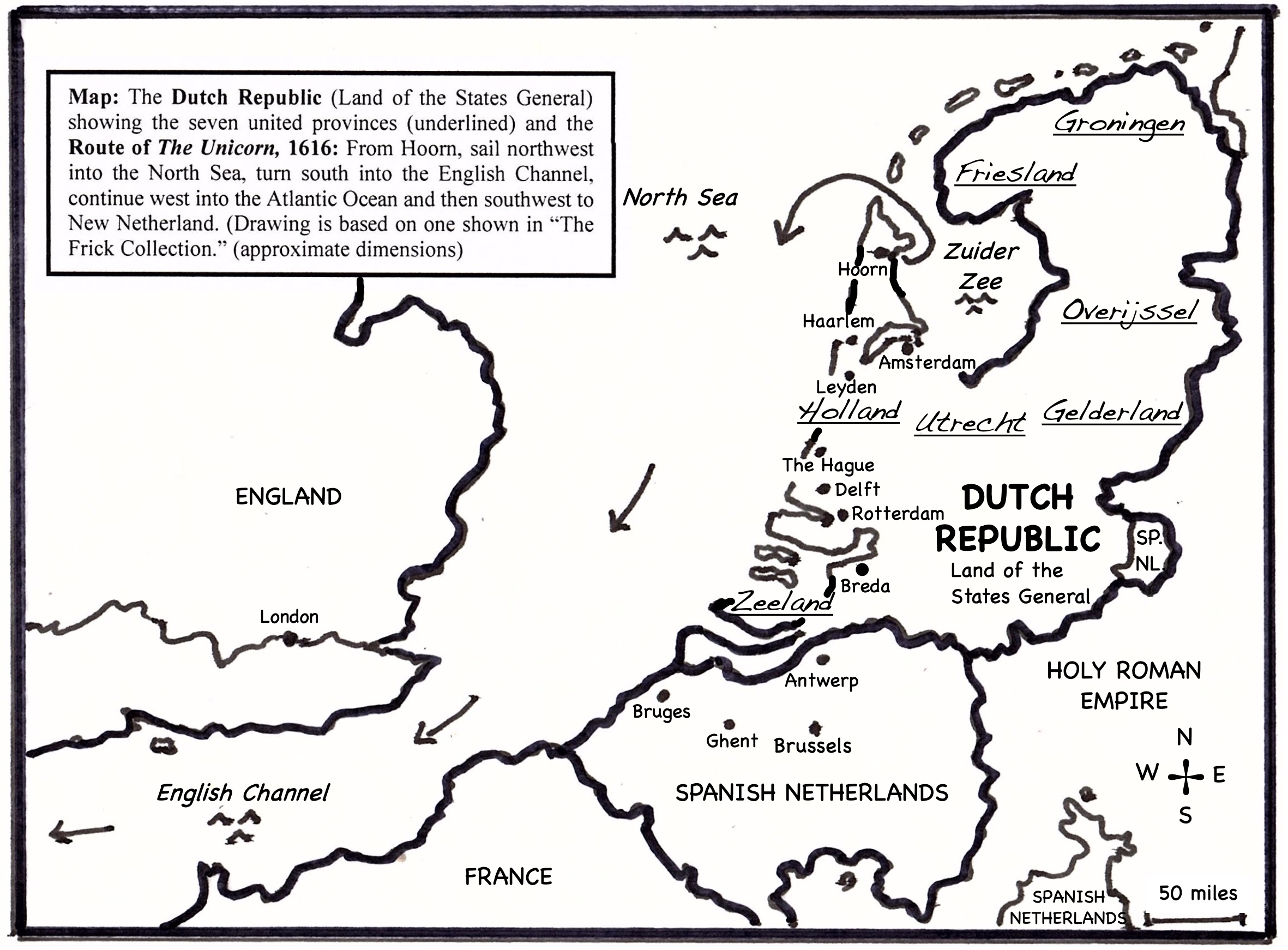
A beautifully blended panorama of Dutch, Iroquois and Algonquin cultures coupled with an engaging plot! This novel is a valuable addition to the study of early U.S. history, offering a fresh look at the social norms that affect a young person’s value judgments. From the perspectives of both entertainment value and historical interest, JvdZ deserves a place on every young adult’s bookshelf!
This book was amazing. I loved every minute of it especially since I sail almost every summer. I think Johannes is a great character due to his effort to be successful. He was hesitant to do some things, but he eventually got over his fears. I loved when he finally did this and swam with Tail Feather. The usage of proper ship terms was really amazing. I like how the story brought to attention the ways of the Native Americans. It actually taught me about their culture. I would totally recommend this book to other people, and I think that other teens would love this book.
An early surveyor in the Adirondack Mountains discovers tattered papers in a leather folder in the ruins of a cabin. Respectfully preserved since this discovery, these pages reveal the life story of an old Native American woman written in the form of a diary and memoir. In the first three books of this series we know her as Sky Flower, then a baby or toddler. An eerie message in the form of a crow’s feather compels her to write the story of her life. And what a story she has to tell!
Of the five books, Sky Flower is the only one written in the first person singular. With quill in hand, the Mohawk writer records her life from her early memories when a combination of physical ‘assets’ (or, depending upon interpretation, ‘liabilities’) allows her to lead a somewhat privileged life in her tribe. She, in fact, becomes a spoiled child and somewhat of a misfit within her clan. Sky Flower describes the first encounters of her own people with European missionaries and traders.
In early adolescence, Sky Flower finds herself in a Dutch village (Fort Orange at present-day Albany) to serve as caretaker of a sickly child. There, she becomes severely disfigured by smallpox. The change forces her to develop inner resources to overcome this devastating adversity. Eventually, Sky Flower finds employment in a tavern in Nieuw Amsterdam (present-day Manhattan) serving a rough-hewn seafaring clientele.
By a stroke of fate, she later becomes a governess in Littleton (now Shepperton), England, along a sharp bend of The River Thames. There, she serves the children of a well-to-do family for seven years, always learning from a succession of tutors. Increasingly distraught by the expectations and double standards of English society and by a romantic misadventure, she returns to Fort Orange (by now called “Beverwijck” and later renamed by the English “Albany”). Sky Flower starts an informal school for language and arithmetic for children of mixed heritage (on Peebles Island near Watervliet).
In her later years, Sky Flower abandons her ‘civilized’ living, with its conflicting values and its instincts for conflict, for the rigors of a simpler life in an isolated cabin, choosing a mountain place and the ways of her people as she remembered them.
Covering many decades, her memoirs bring out the interaction of new technology and social changes that were an integral feature of the European incursion. The years in England explain her ability to write in accomplished English. She chronicles the fate of her family and other clan members.
Sky Flower experiences the luxuries/hardships of European life as well as the societal hypocrisies that come with it. She witnesses first-hand the inevitable clash of cultures played out in America. She writes of the accepted hardships of a reclusive life in the wilderness. Overall, the book presents in bold relief a personal statement about the tumultuous events of the “Contact Period,” told from a perspective of a long and eventful life.
The memoir writer provides her own version of “Notes About the Story.” She writes of a feather, solitude, an eclipse, Cinderella, a Chinese vase and a sea bird among a world of experiences
HISTORICAL OVERVIEW
During Sky Flower’s lifetime the European stage is dominated by major religious and political warfare both on sea and on land. Naval battles between European nations and between European merchant ships and pirates along the Barbary coast continue throughout the century. In the Mediterranean Sea confrontations between Venetian, Spanish, Dutch, Portuguese, French and English ships and those of the Ottoman Empire occur constantly. Settlements along the Atlantic Ocean and North Sea are also vulnerable to attacks, and even the island of Lundy in the Bristol Channel becomes a stronghold of Muslim pirates. Villages in Cornwall and Devon are particularly hard hit.
Pirates or “corsairs” of all ethnicities capture not only valuable cargos but people from coastal towns to be sold as slaves or ransomed. Captured Christians often convert to Islam to save their own lives. Captured Muslims, too, often become Christians for the same reason. Some English who helped the privateer Francis Drake defeat The Spanish Armada in 1588 become pirates themselves.
Sky Flower’s voyages to and from England are undertaken against this perilous backdrop. The risk of capture and death at the hands of pirates as well as the theft of cargo always cause grave concerns for those aboard any ship. While the Mohawk girl might be unaware of these dangers, the captain, the crew, and the investors in the mercantile shipping trade certainly would not be. In the home of an English noble family, Sky Flower will learn about another aspect of oceanic travel: the European involvement in the African slave trade.
On the continent, the first half of the 17th century is dominated by conflicts between the Catholic forces of the Austria and Spain and the Protestant forces led by the Dutch in their War of Independence and by the Swedes under King Gustavus Adolphus. Catholics consider the Calvinists (Huguenots), Lutherans, and other independent sects to be heretics, worthy of punishment by the ongoing Inquisition. Protestant groups, on the other hand, condemn Roman Catholics and members of the Church of England as “Papists” who defy the true tenets of Christianity. Hypocrisy, cruelty, revenge, and superstition are the hallmarks of religious fervor at this time. Sky Flower is first exposed to some of these problems during her conversations with Bertrand, a prisoner on the ship heading to England, and later with Harold, a Puritan gardener in England.
In the second half of the century peace prevails in the Dutch Republic, giving rise to the Golden Age of Science and the Arts. In England, however, chaos continues. The monarchy is overthrown, then replaced by Parliamentarians under Cromwell and is finally restored. Sky Flower will learn of these political events long after she returns to her homeland.
GLOBAL TIMELINE 1613-1692, sample pages
Year (Sky Flower’s Age and Location)
1613 (Birth of Sky Flower, Mohawk village of Tahawus, Adirondack Mountains)
Captain Adriaen Block sails up the Noordrivier (Hudson River) in the ship, Tijger (Tiger).
1614 (age 1, Tahawus)
- Construction of a small ship, the Onrust, during the winter on Manhattan Island (after burning of the Tijger.) Block uses the ship to explore Long Island Sound up to Rhode Island, including the Connecticut River. Rood (red) Eyelandt was changed to Rhode Island by the British.
- Galileo publishes evidence that sunspots (or dark areas) are planets that orbit around the sun. This “Heliotropic Theory of the Universe” is, to the church, “foolish and absurd” because it goes against Holy Scripture.
1615 (age 2, Tahawus)
First publication of a book for women, The English Huswife. Later it appears as Book Two in a two-volume edition, Countrey Contentments or the English Huswife containing The Inward and Outward Vertues which ought to be in a compleate Woman.” Written by a man, Gervase Markham, it contains instructions that cover everything from preparing feasts to medical remedies.
1617 (age 4, Tahawus)
The fourth edition of England’s first dictionary, A Table Alphabeticall, is published and in “plaine English” and is “gathered for benefit and helpe of Ladies, Gentlemen and other unskilful persons.” The listing with brief definitions begins with the word “‘abandon’ (cast away or yeelde up)” and ends 3,263 words later with “zodiack (a circle in heaven… in which the Sunne is mooved).” The only existing copy of this dictionary is in the main library at Oxford University. The dictionary was the work of a maverick priest, Robert Cawdrey of Oakham, a town in central England. Defrocked from the clergy, Cawdrey became a schoolmaster. Little is known about the life of this tenacious scholar.
1620 (age 7, Tahawus)
- Separatists from England establish a colony in Plymouth, Massachusetts.
- England and Holland begin a truce over the spice trades; it lasts three years.
- William Shakespeare dies.
1621 (age 8, Tahawus)
- Eleven African men are brought to New Amsterdam as slaves of the Dutch West India Company.
1623 (age 10, Tahawus)
- Pocahontas, daughter of a Powhatan chief, is kidnapped by English colonists in Jamestown, Virginia.
- The First Folio of Shakespeare’s plays is published posthumously. The publication likely saved most of the eighteen histories, comedies, and tragedies from extinction. Now digitalized, the originals are currently accessible at Oxford University.
1624 (age 11, Tahawus)
- Pocahontas converts to Christianity and marries the English planter, John Rolph, in Jamestown.
- Dutch traders settle first on an island in New York Harbor, keeping cattle and constructing a fort and a sawmill. They call it Noten Eylandt, adapting the Lenape name of Paggunuch or Paggank, which refers to the island’s abundant nut trees (chestnut, oak and hickory). The English called the island “Nutten” until 1874 when the name was officially changed to Governors Island.
1626 (age 13, Tahawus)
- Pieter Minuit purchases Manhattan Island from the local Canarsees for a pittance. They call it Nieuw (New) Amsterdam.
- English fishermen plying the northeastern coast above Boston begin a settlement called Naumkeag, named after a local indigenous tribe. That name was later changed to Salem, the Hebrew word for “peace.”
1627 (age 14, Fort Orange, New Netherland — now Albany.)
- In Japan, the shogun prohibits Christianity, beginning a 200‐year policy of isolationism. Later the door shuts completely when citizens are forbidden to leave the island.
- William Harvey demonstrates convincing evidence that the blood circulates and that the heart acts as the pump. He has no way to understand why the blood circulates or, without the microscope to visualize capillaries, how the out‐going blood from the heart connects to the returning blood.
- A few emigrants from the Massachusetts Bay Colony begin a settlement in Salem.
1628 (age 15, New Amsterdam, New Netherland, now New York City.)
- England grants a royal charter to the Massachusetts Bay Colony; Puritans from the Colony settle in Salem.
- The Siege of La Rochelle: French Protestants (Huguenots) are attacked by the royal forces of Catholic King Louis XIII under Cardinal Richelieu and are made to surrender.
- Holy Roman Emperor Ferdinand II of Austria-Hungary demands that Protestants in his country convert to Catholicism.
1629 (age 16, Littleton, England)
- The “Thirty Years War” begins, pitting the Swedish Protestants, followers of Martin Luther, against the Roman Catholic Church.
- The reign of King Charles I begins in England. His insistence on “divine right” clashes sharply with Parliament’s authority of government and eventually leads to his demise.
1630 (age 17, Littleton, England)
- In the spring, one thousand Puritans from Boston, England sail to the Massachusetts Bay Colony, arriving first in Salem, but soon relocating to Charlestown. Reverend John Winthrop is appointed Governor. Within six years, the number will increase to 17,000.
- The Dutch West Indies Company establishes a sugar‐growing plantation in New Holland (the area today known as Brazil). After fourteen years and many battles on sea, the Dutch are forced out by the Portuguese and Spanish.
- Anthony Janszoon van Salee, son the Muslim Dutch pirate at Lundy Island, settles peacefully as a colonist in New Amsterdam.
1631 (age 18, Shepperton, England)
- Mount Vesuvius in Campania in southern Italy begins a new cycle of volcanic activity that results in several subsequent eruptions. The burial of Pompei and Herculaneum by molten rock occurred in the original eruption of 79 A.D.
- The Massachusetts Bay Colony establishes settlements in Boston and Cambridge.
1633 (age 20, Littleton, England)
- The Dutch Republic, (shortened form of the “Dutch Republic of the Seven United Provinces of the Netherlands”), experiences the world’s first catastrophic market collapse centered on a three-year speculation craze about tulip bulbs. Outrageous prices were based upon the beauty of the resulting flower.
- The Inquisition in Rome convicts Galileo of heresy because of his published scientific findings about the universe.
- The town of Williamsburg, Virginia is founded.
1634 (age 21, Littleton, England)
The first settlers arrive in present‐day Maryland. From England, George Calvert (Lord of Baltimore) champions a colony tolerant of all religions. Here, harassed Catholics in Protestant England eventually find a haven.
Dr. Phillips’s fourth installment in his River Quintet series reveals that the stories we tell, our personal stories, harbor within them the unmistakable impact — the tints and tinges — of a global milieu. Sky Flower roots its readers in the homecoming and introspections of a life lived across, between, and through two worlds: a singular life of an Indigenous Mohawk woman consumed by her cultural indoctrination to serve white colonial efforts and the greater historical contexts of seventeenth-century America and Europe. In this way, Sky Flower is a timely and edifying tale, revelatory of the social reckoning long overdue in our own twenty-first century.
Grounded in the aged voice of Sky Flower, who “found life to be truthful, dull,” this stunning fictional memoir turns such sentiment on its head to reveal a rich and complicated existence. The details mesh and pass through each other, connect and rebound, just like the narrator’s namesake — a sky flower, or rainbow, whose refraction and dispersion of the sun’s light captures the attention of all who encounter it, presenting the wonder, strength and beauty of the ephemeral in the face of atmospheric (environmental, cultural, social) disturbance.
Sky Flower braids a bittersweet tale of affinity with “the gentle earth” just as it releases its narrator from the bonds of belonging to any one world. It is an important vehicle through which to witness the weaving of historical influence and embrace the differences that bind us together.
Born deaf, a condition unrecognized for several years, Mary proves a misfit within the well-disciplined expectations of a Lord’s Manor House in England during the Stuart Period. Her disruptive ways exasperate the entire household, leaving Mary isolated from her sisters and brother.
When Mary is nine years old, a young woman from the Colonies arrives at the Manor House and becomes the governess. It is she, a Native American named Sky Flower, who discovers the little girl cannot hear.
Together, Mary and Sky Flower develop their own ‘hand’ language based on fragments remembered of the custom practiced by Native American travelers. Ever-deepening bonds between the two are inevitable. Mary turns out to be energetic, intelligent, resourceful and talented, particularly at drawing. She has a winning way with animals, large and small. Still, she remains misunderstood by her family. After seven years, Sky Flower suddenly abandons the Manor House for a romantic interest, leaving Mary crushed in spirit. Her recovery from this devastating blow comes from the opportunity of raising her own new-born foal. There follows a growing relationship and total devotion between girl and horse.
Circumstances bring Mary, now at age seventeen and having proven her resourcefulness, on a ship with her horse to the Colonies in 1639. There she arrives at farming community along the Connecticut River in what is now Hartford. Living with a Puritan family of strict moral guidelines, Mary finds life in the rough not at all like that of the Manor House. Her relationship with the children of the family becomes complex. Mary unwittingly finds herself helping others cope with their personal challenges. There are moments when she, riding her horse, Angel, explores in solitude the natural beauty of the New World.
Good at drawing and able to perform heavy work in the garden and stables, Mary spends one year in the Colonies. During this year, Dutch traders bring materials from New Amsterdam to a fort not far away. Mary develops a special interest in one of the traders, and maturing feelings of a young woman are not unexpected. The predictable romantic story, however, is not predictable.
This novel gives an account of growing up deaf and the struggle to make one’s way in the family and the world in general. It happens at a time when there is little understanding of deafness and where there are no effective strategies to cope with such an all-imposing but invisible handicap.
The plot provides a full emotional perspective – from crushing disappointment to deeply felt joy – from a privileged life in England to a hardscrabble one on a colonial riverside plantation almost 400 years ago.
The book contains 72 mini-essays that range from training of horses to magpie, wariness of witches, nutmeg, the prism and the role of colonial women.
| Chapter | Note | Title of Note |
|---|---|---|
| 2 | 1 | Littleton |
| 3 | 2 | Magpie |
| 3 | 3 | Puppet Show |
| 3 | 4 | Toys & Games of 17th Century England |
| 3 | 5 | Insanity: Changing Attitudes |
| 3 | 6 | Hard-of-Hearing With Aging |
| 4 | 7 | The River Ash |
| 4 | 8 | Horse: Attraction |
| 4 | 9 | New Amsterdam |
| 5 | 10 | Pocahontas |
| 5 | 11 | Smallpox: Immunity |
| 5 | 12 | Gwendolyn: Origin of Name |
| 6 | 13 | Sir Francis Drake |
| 7 | 14 | Deafness: Children |
| 7 | 15 | Chinese Vase |
| 7 | 16 | The Royal College of Physicans |
| 7 | 17 | Deafness: Early Attitudes |
| 8 | 18 | Deafness: Traditional Treatment |
| 8 | 19 | Deaf: Education |
| 9 | 20 | Prism |
| 9 | 21 | The River Thames |
| 10 | 22 | Orangery |
| 10 | 23 | Horse: Domestication |
| 11 | 24 | Blacksmith |
| 11 | 25 | Vibrations |
| 12 | 26 | Iron Horse |
| 16 | 27 | Foal |
| 16 | 28 | Horse |
| 24 | 29 | Staines |
| 24 | 30 | Windsor Castle |
| 25 | 31 | Puritans: Plymouth and the Massachusetts Bay Colony |
| 26 | 32 | Pudding Lane |
| 26 | 33 | Countrey Contentments or The English Huswife |
| 27 | 34 | Quayside: London |
| 28 | 35 | Animals: Ship Transport |
| 30 | 36 | Gervase Markham (B. 1568 – D. 1637) |
| 31 | 37 | Fisher’s Island |
| 33 | 38 | Connecticut River |
| 33 | 39 | Leadsman or Plumb Lead Line |
| 32 | 40 | Bodkin Rock |
| 34 | 41 | Fainting |
| 35 | 42 | Hartford: The Beginning |
| 35 | 43 | Nutmeg |
| 37 | 44 | Food |
| 39 | 45 | Horses: North America |
| 41 | 46 | Colonial House |
| 42 | 47 | Diaspora |
| 42 | 48 | Reverend Thomas Hooker |
| 43 | 49 | Oxen Versus Horses |
| 44 | 50 | First People |
| 45 | 51 | Migraine |
| 48 | 52 | Colonial Women |
| 49 | 53 | Historical Data |
| 50 | 54 | Dutch Fort and Trading Post: House of Good Hope |
| 50 | 55 | Neighbors: The Dutch and the English |
| 52 | 56 | Meeting House |
| 52 | 57 | Connecticut Constitution |
| 54 | 58 | Dutch Sloop |
| 66 | 59 | Spring Peepers |
| 66 | 60 | Bathing |
| 69 | 61 | Hartford: The City |
| 70 | 62 | Flood |
| 71 | 63 | Quinsy |
| 74 | 64 | Almandine |
| 78 | 65 | Witch |
| 83 | 66 | John Donne |
| 84 | 67 | Cavern Versus Cave |
| 85 | 68 | Sonnet |
| 97 | 69 | Horse: Leg Injury |
| 90 | 70 | Asperger’s Syndrome |
| 91 | 71 | Delftware Pottery |
| 97 | 72 | Grass |
The novel, Mary Walsingham, is a great resource for students at the high school level as her story provides a live narrative of the Deaf experience in the 1600s. Mary was a smart individual who could not grasp "what was happening around her" and that "talking requires sound and for Mary, the world was soundless. She did not know what hearing was; she did not know that she was deaf." The narrative goes into detail regarding her coming of age and discovering the world as a deaf individual… I loved the story and plan to use excerpts in my ASL classroom.
The most lyrical and the most soul-searching novel of The River Quintet series, Book 5 is the story of a deaf girl’s empowering journey to self-determination. Through the clever integration of characters introduced in the earlier books, the author brings together elements of good storytelling: intrigue, conflict, joy, disappointment, heartache, and hope. Mary Walsingham is a tenacious girl who overcomes grief at two milestones in her life. On a larger scale, the novel can be considered an eye-opener of social customs and beliefs in Stuart England and the Puritan colony of early Hartford, CT.
A treat for all readers is the impressive reference section called NOTES ABOUT THE STORY. The author, Dr. Ray E. Phillips, includes mini-essays on the treatment of deafness by the medical profession and the development of visual communications for the deaf person. Extensive as well are his notes about horses, historical events, and other matters of health in the 17th century. The LIST OF NOTES in table form is a welcoming and convenient tool for finding a particular topic. Hats off to the author of this phenomenal novel!
Imagine a perfect bow. Once untied, it is difficult to retie the ribbon into its original beauty.” Ray Phillips’s fifth installment of his River Quintet series presents a powerful bildungsroman ignited at the point of rupture when Sky Flower departs for the New World, leaving behind a bewildered Mary. Mary Walsingham: Coming of Age in Two Silent Worlds breathes life into its eponymous protagonist, whose deafness emerges as a powerful foil for finding connections and solving afflictions—for herself and for those to whom her travels link her. Book 5 launches Mary into her own odyssey as she navigates through the turbulent colonialism of 17th century England toward the strict principles of the Puritans in the New World, their reliance on Dutch traders and an uneasy peace with the Indigenous Podunks. This flowing, captivating tale maps the confluence of destiny and circumstance to reveal that belief in oneself is synonymous with the strength to embrace an imperfect world and find the beauty and release in a useful life.
Although most of my writing has been on subjects of clinical medicine, the historical novels have provided a medium for a life-long interest in history and the human experiences of long ago. Developing timeless and realistic characters of both genders brings into focus my own experiences with people facing a broad spectrum of big and little challenges.
These stories have kindled my admiration for the First People of America. Placed in a setting of the woodlands and waterways along our great river, we can relive the early colossal changes in society and technology that came to them in 17th century America. The stories have also led to my creating a close interface between the First People and those who crossed the ocean and contributed to these changes.
In this series of five interconnected but stand-alone historical novels, we follow the lives of youthful characters on journeys through geographic, cultural and personal challenges. The settings are northeastern North America, England and Holland – as well as oceanic voyages.
Through the novels, readers may find a historical continuity and personal satisfaction in visiting lives lived long ago under far different situations. The study of history develops a sense of how the world came to be; the historical novels bring you there. As author of The River Quintet, I envision these fictionalized biographies as reminders of the delicate but enduring thread that is woven throughout the lives of all people in all history.
The stories, based upon careful research of the time and place, are complemented by extended factual information in the form of a “mini-essay.” These extended footnotes are descriptions of people, places, events and the natural world that come up in the story. The combination of story and fact is cross-referenced for easy accessibility to background information without interrupting the flow of the story.
The Companion Guide provides the reader with a practical approach for understanding and utilizing The River Quintet series in grades 7 through 12. Key aspects of the stories as they pertain to the Social Studies and the English Language Arts curricula are noted. Questions are designed to be thought-provoking–challenging the student to reflect on the commonalities and the vast differences in the Native American and the Dutch and English colonial cultures of the 17th century. Website references, as well as the List of Notes and the historical overview from the novels, are included.
“Dr. Sheeran’s Companion Guide offers a multidisciplinary approach to incorporating the historical coming-of-age novels of Ray E. Phillips into the classroom. Her well organized, in-depth and succinct presentation contains summary information, sample assessment questions, projects and class activities, references for further investigation, and much more. This highly accessible teacher’s guide reveals the intense value of helping students to comprehend historical frameworks through diverse individual and collective perspectives.”
“Thorough and inspiring!”
It is an incredibly helpful resource!
A Companion Guide to The River Quintet Series provides a clear synopsis of all five books in this wonderful collection, including an overview of the stories and major themes addressed. Founded in strong pedagogical theory, the Guide offers engaging ideas for lessons, activities, and assessments. It also highlights the possibilities of use of the series across the curriculum, in ELA, the Humanities, and Social Science classes at the secondary level. These texts offer students a window into the experiences, culture, and challenges of Native youth after the arrival of European settlers. Students have the opportunity to explore geography, history, culture, character, citizenship and intersectionality. Teachers will be grateful for the organized presentation of information, thoughtfully posed guided reading questions, and answer keys. Educators will have the opportunity to seamlessly integrate the novels into their curriculum with the aid of this companion guide.
